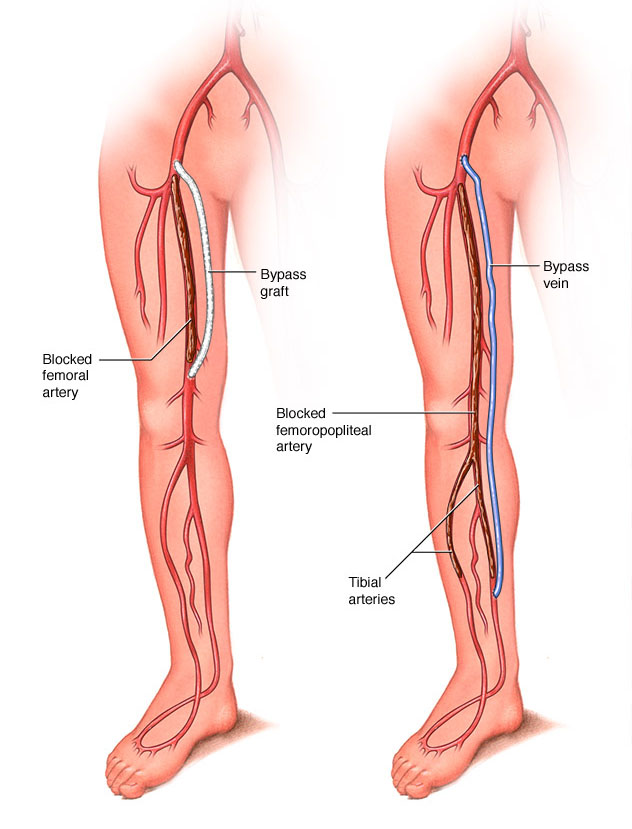Treatment of PAD (Peripheral Artery Disease)
Peripheral artery disease (PAD) treatment primarily aims to alleviate symptoms and halt the progression of the disease. Lifestyle modifications, exercise, and medications for claudication are typically effective in managing PAD symptoms and potentially reversing its progression.
Diagnosis:
– Physical examination: Your doctor may detect signs of PAD during a physical exam, such as weakened pulses, bruits (whooshing sounds over arteries), evidence of poor wound healing, and decreased blood pressure in the affected limb.
– Ankle-brachial index (ABI): This test compares blood pressure in your ankle to that in your arm, assessing blood flow and severity of artery narrowing during exercise.
– Ultrasound: Doppler ultrasound evaluates blood flow and identifies blocked or narrowed arteries.
– Angiography: This procedure involves injecting contrast material into your blood vessels to visualize blood flow using X-ray, magnetic resonance angiography (MRA), or computerized tomography angiography (CTA).
– Blood tests: Cholesterol, triglycerides, and diabetes levels are measured to assess risk factors.
Treatment:
– Symptom management: Lifestyle changes and medication aim to alleviate leg pain and improve physical activity.
– Atherosclerosis prevention: Lifestyle modifications and medication aim to reduce the risk of heart attack and stroke.
– Lifestyle changes: Smoking cessation is crucial. Regular exercise improves symptoms and helps your body use oxygen more efficiently.
– Medications: Cholesterol-lowering drugs (statins), blood pressure medications, blood sugar control medications (for diabetes), and medications to prevent blood clots (aspirin, clopidogrel) may be prescribed.
– Symptom-relief medications: Cilostazol increases blood flow and widens blood vessels, relieving claudication symptoms. Pentoxifylline is an alternative with fewer side effects.
Your treatment plan may include a supervised exercise program to improve walking distance without pain. Medication aims to control cholesterol, blood pressure, blood sugar, and prevent blood clots. These interventions, combined with lifestyle changes, help manage PAD and reduce the risk of complications.
Medications:
– Cholesterol-lowering medications: Statins are prescribed to reduce the risk of heart attack and stroke by lowering LDL cholesterol levels. The target for individuals with peripheral artery disease is LDL cholesterol below 100 mg/dL (2.6 mmol/L), with lower targets for those with additional risk factors such as diabetes or smoking.
– High blood pressure medications: If you have hypertension, medications are prescribed to lower systolic blood pressure to 140 mm Hg or lower and diastolic blood pressure to 90 mm Hg or lower. For individuals with diabetes, the target is under 130/80 mm Hg.
– Medication for blood sugar control: Effective management of blood sugar levels is crucial for individuals with diabetes. Discuss with your doctor to establish blood sugar goals and determine the necessary steps to achieve them.
– Medications to prevent blood clots: Daily aspirin therapy or other medications like clopidogrel may be prescribed to improve blood flow and prevent clot formation, considering the reduced blood flow associated with peripheral artery disease.
– Symptom-relief medications: Cilostazol enhances blood flow to the limbs by thinning the blood and dilating blood vessels, alleviating symptoms such as claudication (leg pain). Common side effects include headache and diarrhea. Pentoxifylline is an alternative with fewer side effects, although it is generally less effective.
Graft Bypass:
When peripheral artery disease leads to claudication that cannot be adequately managed with conservative measures, angioplasty or surgery may be necessary:
Angioplasty: During angioplasty, a catheter is inserted into the affected artery, and a small balloon on the catheter’s tip is inflated to open the artery and compress the blockage against the artery wall. This procedure helps to restore blood flow by widening the artery. Additionally, your doctor may deploy a stent, a mesh-like structure, to support the artery and maintain its patency.
Bypass Surgery: In cases where angioplasty is not feasible or effective, your doctor may perform bypass surgery. This involves creating a graft bypass using a healthy blood vessel from another part of your body or a synthetic vessel. By diverting blood flow around the obstructed artery, bypass surgery restores adequate blood supply to the affected area.
Thrombolytic Therapy: When a blood clot obstructs an artery, thrombolytic therapy may be administered. This involves injecting a clot-dissolving medication directly into the artery at the site of the clot to break it down and restore blood flow.


